Jul 17, 2018 | Air Pollution, Energy & Climate, Poverty & Equity, Women in Science, Young Scientists
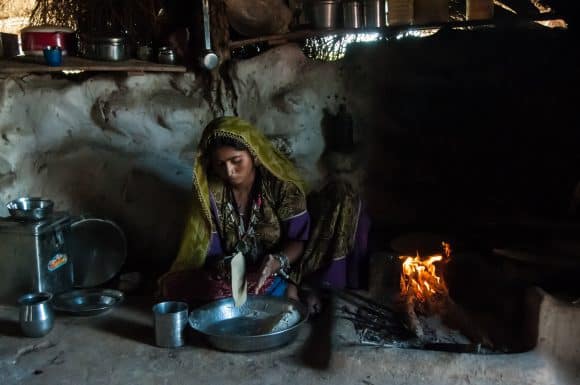
© Stefano Barzellotti | Shutterstock
By Sandra Ortellado, IIASA Science Communication Fellow
When it comes to home cooking in rural India, health, behavior, and technology are essential ingredients.
Consider the government’s three-year campaign to reduce the damaging impacts of solid fuels traditionally used in rural households below the poverty line.
Initiated by the Ministry of Petroleum and Natural Gas, a program called Pradhan Mantri Ujjwala Yojana (Ujjwala) aims to safeguard the health of women and children by providing them access to a clean cooking fuel, liquid petroleum gas (LPG), so that they don’t have to compromise their health in smoky kitchens or wander in unsafe areas collecting firewood.
According to the World Health Organization, smoke inhaled by women and children from unclean fuel is equivalent to burning 400 cigarettes in an hour.
Nevertheless, an estimated 700 million people in India still rely on solid fuels and traditional cooking stoves in their homes. A subsidy of Rs. 1600 (US $23.47) and an interest free loan attempts to offset the discouraging cost of the upfront security deposit, the stove, and the first bottle of LPG, but this measure hasn’t been able to change habits on its own.
Why? Although the government has made an overwhelming effort to increase access, interconnected factors like cultural norms, economic trade-offs, and convenience require an in-depth analysis of human behavior and decision-making.

Abhishek Kar, 2018 YSSP participant ©IIASA
That’s why Abhishek Kar, a researcher in the IIASA Energy Program and a participant in the 2018 Young Scientists Summer Program (YSSP), has designed a study to explore how rural households make choices about access and usage. Borrowing from behavior change and technology adoption theories, he wants to know whether low-cost access is enough incentive for Ujjwala beneficiaries to match the general rural consumption trends, and more importantly, how to translate public perception into a behavior change.
“I think it’s really important to look into the behavioral aspect,” said Kar in an interview. “If you ask someone if they think clean cooking is wise they may say yes, but if you say do you think it is appropriate for you? The moment it becomes personalized the answers can vary.”
Kar knows that although more than 41 million LPG connections have been installed, installment of the connection does not necessarily equate to use. By gathering data on LPG refill purchases and trends, along with surveys that identify biases in the public’s perception, he wants to know how to convince rural BPL households to maintain the habit of using LPG regularly, even under adverse conditions like price hikes. If LPG is used only sporadically, LPG ownership won’t significantly reduce risk for some household air pollution (HAP)-linked deadly diseases, like lower respiratory infections and stroke.
Unfortunately, even the substantial efforts the government has made to improve LPG supply has not changed the public’s perception of its accessibility in the long term, nor its consumption patterns in the first two years. At least four LPG refills per year would be needed for a family of five to use LPG as a primary cooking fuel, which is not currently happening for the majority of Ujjwala customers.
Because the majority of Ujjwala beneficiaries have cost-free access to solid fuels from forest and agricultural fields, there is less incentive for these families to use LPG regularly instead of sporadically. Priority households for Ujjwala, especially those with no working age adults, are often severely economically disadvantaged and can’t afford to buy LPG at regular intervals.
Furthermore, unlike LPG, a traditional mud stove is more versatile and can serve dual purposes of space heating and cooking during winter months. Many prospective customers are also hesitant about the inferior taste of food cooked in LPG, the utility of the mud stove’s smoke as insect repellent, and the trade-off of expenses on tobacco and alcohol with LPG refills.
As per past studies, even the richest 10% of India’s rural households (most with access to LPG) continue to depend on solid fuels to meet ~50% of their cooking energy demand. This suggests that wealth is not the only stumbling block in the transition process.
“Whatever factors matter in the outside world, my working hypothesis is that every decision is finally mediated through a person’s attitude, knowledge, and perceptions of control,” said Kar. According to Kar, interventions can be specifically targeted to address factors that are perceived negatively either by informing people or doing something to improve that factor. Nevertheless, developing effective interventions is no simple task.
Even with a background in physics and management and eight years of experience helping people transition from one technology to another, Kar says he is grateful to have the input of a variety of scholars at IIASA, each with a different perspective and a different set of core skills and experiences. Working in the Energy program alongside IIASA staff and fellow YSSPers from all over the world, Kar puzzles out the unsolved challenge of how to create change for the rural poor.
“That has been one of my drivers, I take it as an intellectual challenge,” said Kar. “Is there a systems approach to the problem?”
For now, Kar is happy if he can return at the end of the day to his family, which he brought with him to Austria during his time as a YSSP participant, feeling like he is opening the door to a vast literature on technology adoption and human behavior, yet untapped in the field of cooking energy access.
“This research is only a very small baby step into trying something different,” said Kar, “I think this sector has so many unanswered questions, if I can at least flag that there is a lot of literature out there in other domains and maybe we can use some of it, I think that would be good enough for me.”
Note: This article gives the views of the author, and not the position of the Nexus blog, nor of the International Institute for Applied Systems Analysis.
Jun 29, 2018 | Communication, IIASA Network, United Kingdom, Women in Science
by Melina Filzinger, IIASA Science Communication Fellow
As a science communication fellow at IIASA, I had the opportunity to talk to Dame Anne Glover, who was recently made an IIASA distinguished visiting fellow. Originally a successful researcher in microbiology, she previously served as the first chief scientific adviser for Scotland, as well as the first chief scientific adviser to the president of the European Commission, and is now president of the Royal Society of Edinburgh.

© Anne Glover
In your roles as scientific adviser you had to know about a broad range of relevant scientific topics. How do you keep informed about topics that lie outside your own area of research?
Of course no-one can be an expert in all the different areas of science. As a microbiologist, I am very specialized, but I am also a generalist when it comes to other areas of research. I keep up to date by reading articles about lots of different topics, from climate change to chemical toxicity or Alzheimer’s research, just because I am curious and interested.
However, if a minister or policymaker asked me to brief them on a particular topic, I would consult organizations with expertise in that area and ask them questions until I felt that I understood the topic. Then I would translate that scientific, often jargon-filled research into something that makes sense to a non-specialist. Part of the role as scientific adviser is not so much being an expert as being a translator.
Do you follow any science publications aimed at a broad audience? What are your favorites?
There is an organization called Sense about Science that publishes reports on issues that are being discussed among the public. They also have a fabulous service called Ask for evidence. Anyone can go onto their website and type a question, for example “Do female contraceptive pills end up feminizing fish in water streams?”, and they have a panel of experts that can comment on that, give you the evidence, and explain why this issue might or might not be a problem. It’s fantastic! I often use these answers as a starting point to find out about something.
I follow several other popular news outlets as well, for example New Scientist or the science and nature section of the BBC news app. I don’t expect absolute accuracy from those, I just expect to get a first impression of a research area. I also use Twitter as a source of information, because people often tweet about interesting science articles.
You are very active on Twitter. Has social media been useful to you, and how can it be used effectively?
I came to Twitter kicking and screaming when I joined the European Commission as chief scientific adviser to the president. I just thought that I had way too much to do to spend time on social media. It was Jan Marco Müller, a former colleague and now head of the directorate office at IIASA, who convinced me that Twitter could actually be a good way to tell people what I was doing, especially since transparency about my work is very important to me.
Have I found it useful? Enormously so! When I was at the commission I used it to see what really got people excited, either in a good way or in a bad way. When people were against a new technology, it helped me to understand their reasons. Tweeting is also an opportunity for me to help other people by highlighting interesting and useful events or initiatives. It can even be a little bit addictive.
How can science communicators and journalists reach a wide audience without oversimplifying scientific content?
The biggest nervousness I see among scientists is that of oversimplification. That is because, if you do oversimplify, you’re not going to upset your lay audience, but you will upset your scientific audience. I struggled with this for quite some time myself. Generally speaking, I would always favor simplification, of course not to the point of saying something that’s not true. I would however encourage scientists to be less afraid of simplification when speaking to a non-scientific audience. You will never be able to please everyone, you can only do your best to make an abstract subject accessible and interesting to people.
Do you have any tips for young scientists to make their work visible to the public?
In many cities there are science centers, museums, and other places where people get together, and there is nothing, other than their own modesty, to stop a young scientist from offering to talk about their work there. If it seems too daunting to do that kind of thing on your own, you could maybe do it with some of your colleagues. There are lots of opportunities out there for young scientists. Nobody is going to give those opportunities to you, but nobody is going to stop you either! You just have to take them!
If you do take them, think about what audience you are trying to reach beforehand, for example, if you want to talk to children or young adults. Then just be creative in how you present your research–try to build a story. Two good things will come out of it: one is that even if only 50 people show up, and only five of them are interested in what you are saying, you will have transformed the lives of those five people and made them excited about something. That is an achievement. The second thing is, that if you are doing things like that, and the young scientist next to you isn’t, it makes you different, and you have added value. You will also gain experience in communicating, which in turn will make the impact of your science much greater in the future. Everybody wins really, and it can be good fun as well.
Note: This article gives the views of the authors, and not the position of the Nexus blog, nor of the International Institute for Applied Systems Analysis.
Jun 18, 2018 | Alumni, Ecosystems, Environment, Women in Science, Young Scientists
By Cecile Godde, PhD student at the University of Queensland, Australia and former IIASA YSSP participant

Cecile Godde ©Oli Sansom
Last year, I had the fantastic opportunity to spend three months at IIASA as part of the Young Scientists Summer Program (YSSP), to collaborate with the Ecosystems Services and Management (ESM) research program. During this very enriching experience, both intellectually, socially, and culturally, I worked with Petr Havlik, David Leclère, and Christian Folberth on modeling global rangelands and pasturelands under farming and climate scenarios. I also progressed on the development of a global animal stocking rate optimizer. The overall objective of this YSSP project, and more broadly of my PhD, is to assess the role of grazing systems in a sustainable food system.
However, my trip to IIASA was not my only adventure last year. Just before moving to Vienna, I received the great news that I was selected along with 77 other women to take part in a women in science and leadership program called Homeward Bound.
What would our world look like if women and men were equally represented, respected, and valued at the leadership table? How might we manage our resources and our communities differently? How might we coordinate our response to global problems like food security and climate change?
Homeward Bound is a worldwide and world-class initiative that seeks to support and encourage women with scientific backgrounds into leadership roles, believing that diversity in leadership is key to addressing these complex and far-reaching issues. The program’s bold mission is to create a 1000-strong collective of women in science around the world over the next 10 years, with the enhanced leadership, strategic, and visibility capacity to influence policy and decision making for the benefit of the planet.

Antarctic penguins © Cecile Godde
This year-long program culminated in an intensive three-week training course in Antarctica, a journey from which I have just come back. The voyage to Antarctica was incredible. We learnt intensively during this 24/7 floating conference in the midst of majestic icebergs, very cute penguins, graceful whales, and extraordinary women from various cultures and backgrounds, from PhD students to Nobel Laureates. I have returned full of hope for the planet, deeply inspired, and emotionally energized. It was a truly unforgettable experience, one that will keep me reflecting for a lifetime.
Our days in Antarctica typically followed a similar routine – half of the day was dedicated to a landing (we visited Argentinian, Chinese, US, and UK research stations) and the other half to classes and workshops. We discussed systemic gender issues and learnt about leadership styles, peer-coaching, the art of providing feedback, science communication, core personal values, or what matter to us. The list goes on! We were also encouraged to practice reflective journaling. Regularly recording activities, situations, and thoughts on paper is actually a very powerful technique for self-discovery and personal and professional growth as it helps us think in a critical and analytical way about our behaviors, values, and emotions. We also spent quite some time developing our personal and professional strategies: What is our purpose as individuals? What are our core values, aspirations, and short- and long-term goals? From that, we developed a roadmap that could be executed as soon as we stepped off the ship. While I haven’t solved all my life’s mysteries, this activity gave me strong foundations to keep growing and actively shape my own life, rather than letting society do it for me.
In the evenings, we watched our film faculty sharing their tips with us on television, including primatologist Jane Goodall, world leading marine biologist Sylvia Earle, and former Executive Secretary of the UN Framework Convention on Climate Change (UNFCC), Christiana Figueres. We also had a collective art project called “Confluence: A Journey Homeward Bound”, which was underpinned by our inner journey of reflection, growth, and transformation and our outer physical journey to Antarctica.
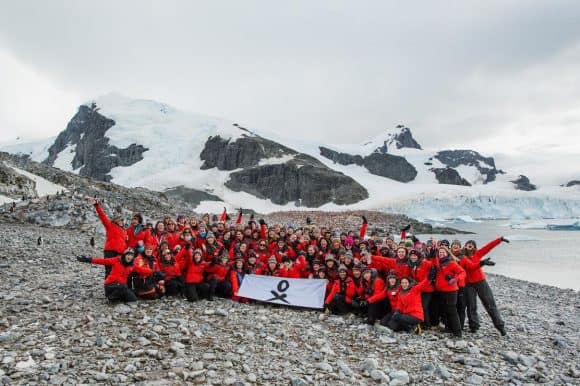
Homeward Bound in Antarctica © Oli Sansom
Both my stay at IIASA and my journey to Antarctica taught me a lot about the value of getting out of my comfort zone, exploring different leadership styles, and collaborating. I have also witnessed how visibility (visibility to ourselves, to understand who we are, and visibility to others, to let the world know we exist) helps to open up opportunities. The good news is that the beliefs we have about ourselves are just that – beliefs – and these beliefs can be changed.
My visibility to others has also increased notably in relation to my involvement in Homeward Bound and my recent award of the Queensland Women in STEM prize. This Australian annual prize, awarded by the Minister for Environment and Science, Leeanne Enoch and Acting Chief Scientist Dr Christine Williams, aims to celebrate the achievements of women who are making a difference in the fields of science, technology, engineering, and mathematics. As a result, I have been contacted by fascinating people from various fields of work, from researchers and teachers to entrepreneurs, start-ups, and industries. All these connections have broadened my approach to food security and global change and helped me shape my research vision, purpose, and values.
When we were in Antarctica, our story reached 750 million people. Why? Because, and may we never forget, the world believes in us – ‘us’ in its broadest sense: humans, scientists, women, etc. – in our skill, compassion, and capability. While we are facing alarming global social, economic, and environmental challenges, I believe that the many collaborations that embrace diversity of knowledge, skills, processes, and leadership styles that are currently emerging all around the world, will help us get closer to our development goals.
Homeward Bound is a 10-year long initiative. Find out more about the program and how to apply here: http://homewardboundprojects.com.au
Follow my journey: –
Jun 4, 2018 | Demography, Postdoc, Poverty & Equity, Women in Science
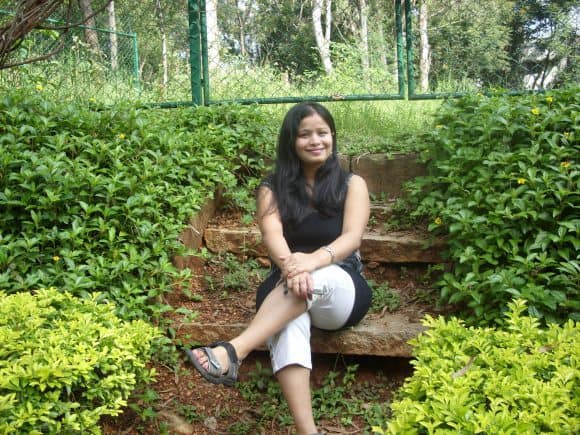
©Nandita Saikia
By Nandita Saikia, Postdoctoral Research Scholar at IIASA
Being an author of a research article on excess female deaths in India in Lancet Global Health, one of the world’s most prestigious and high impact factor public health journals, today I questioned myself: Did I dream of reaching here when I was a little school going girl in the early nineties in a remote village in North East India?
I am the fourth daughter of five. In a country like India, where the status of women is undoubtedly poorer than men even now, and newspapers are often filled with heinous crimes against women, you may be able to imagine what it meant being a fourth daughter. Out of five sisters, three of us were born because my parents wanted a son. My mother, who barely completed her school education, did not want more than two children irrespective of sex, but was pressurized by the extended family to go for a boy after a third daughter and six years of repeated abortions.
I was told in my childhood that I was the most unwanted child in the family. I was a daughter, terribly underweight until age 11, and had much darker skin than my elder sisters and most people from our area, who have fairer skin than average in India. At my birth, my father, a college dropout farmer, was away in a relative’s house and when he heard about the arrival of another girl, he postponed his return trip.
This is a real story, but just one of those still happening in India. The fact that the girls of India are unwanted was observed from the days of early 20th century when it was written in the 1901 census:
“There is no doubt that, as a rule, she [a girl] receives less attention than would be bestowed upon a son. She is less warmly clad, … She is probably not so well fed as a boy would be, and when ill, her parents are not likely to make the same strenuous efforts to ensure her recovery.”
Regrettably, our current study shows that negligence against “India’s daughter” continues to this day.
Discrimination against the girl child can be divided in two categories: before birth and after birth. Modern techniques now allow sex-selective abortion. Despite strong laws, more than 63 million women are estimated to be ‘missing’ in India and the discrimination occurs at all levels of society.
Our present study deals with gender discrimination after birth. We found that over 200,000 girls under the age of five died in 2005 in India as a result of negligence. We found that excess female mortality was present in more than 90% of districts, but the four largest states of North India (Uttar Pradesh, Bihar, Rajasthan, and Madhya Pradesh) accounted for two thirds of India’s total number.
I have to tell you that I was luckier than most girls. Although I was an unwanted child in our extended family, to my mother, this underweight, dark-skinned, little girl was as cute as the previous ones! She gave her best care to her daughter, and she named her “Rani” meaning “Queen” in Assamese. I am still called by this name in my family and in my village.
When I grew up, I asked her several times about her motive for calling me Rani. She always replied: “You were so ugly, the thinnest one with dark skin, I named you as “Rani” because I wanted everyone to have a positive image before seeing you! Also, it is the name of my favorite teacher in high school and she was also a very thin but bright lady!”
The positive conversations with my mother played a crucial role to my desire to have my own identity, and influenced greatly my positive image of myself and my belief that I could do something worthwhile with my life. Much later, when I started my PhD at International Institute for Population Sciences (IIPS), Mumbai, I was surprised to learn that in Maharashtra, one of the wealthiest states of India, second or third daughters are not even given a name, but instead are called ‘Nakusha’, meaning unwanted.
My parents were passionate about educating their daughters, even with their limited means. My father, who was disappointed at my birth, left no stone unturned for my education! By the time I completed secondary school, our village, as well as neighboring villages, congratulated me during the Bihu celebration (the biggest local gathering) for my good performance in school exams. My parents were proud of me by that time; yet, for some strange reason, they always felt themselves weaker than our neighbors who had sons.
Now, people from our village are proud of me not just because I teach in India’s premier university, or that I take several overseas trips in a year, but because they realize that daughters can equally bring renown to their village; daughters can be married off without a dowry; daughters can equally provide old age care to their parents; daughters too can buy property! Due to this attitude and lower fertility levels, many couples now don’t prefer sons over daughters. In a village of 200 households, there are 33 couples that have either one or two daughters, yet did not keep trying for sons. In my own extended family, no one chooses to have more than two children irrespective of their sex. The situation has changed in my village, but not everywhere.
What is the solution of this deep-rooted social menace? We cannot expect a simple solution. However, my own story convinces me that education can be a game changer, but not necessarily academic degrees. I mean a system by which girls realize their own worth and their capability that they can be economically and socially empowered and can drive their own lives. With the help of education, I made myself from an “unwanted” to a wanted daughter!
The purpose of sharing my story is neither self-promotion nor to gain sympathy, rather to inspire millions of girls, who face numerous challenges in everyday life just because of their gender, and doubt their capability, just like I did in my school days. They can make a difference if they want! Nothing can stop them!
May 28, 2018 | Air Pollution, Climate, Climate Change, Ecosystems, Energy & Climate, Women in Science
By Beatriz Mayor, Research Scholar at IIASA
On 14 and 15 May, Vienna hosted two important events within the frame of the world energy and climate change agendas: the Vienna Energy Forum and the R20 Austrian World Summit. Since I had the pleasure and privilege to attend both, I would like to share some insights and relevant messages I took home with me.
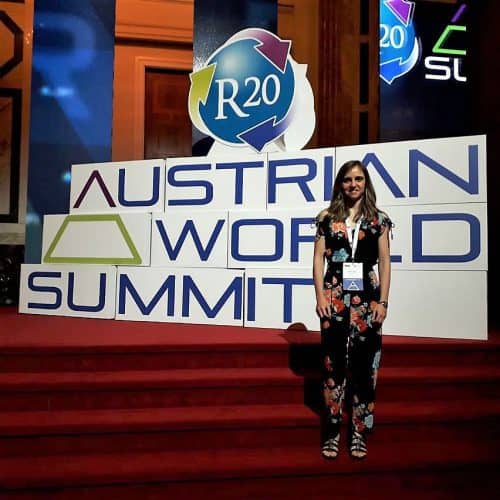
Beatriz Mayor at the Austrian World Summit © Beatriz Mayor
To begin with, ‘renewable energy’ was the buzzword of the moment. Renewable energy is not only the future, it is the present. Recently, 20-year solar PV contracts were signed for US$0.02/kWh. However, renewable energy is not only about mitigating the effects of climate change, but also about turning the planet into a world we (humans from all regions, regardless of the local conditions) want to live in. It is not only about producing energy, about reaching a number of KWh equivalent to the expected demand–renewables are about providing a service to communities, meeting their needs, and improving their ways of life. It does not consist only of taking a solar LED lamp to a remote rural house in India or Africa. It is about first understanding the problem and then seeking the right solution. Such a light will be of no use if a mother has to spend the whole day walking 10 km to find water at the closest spring or well, and come back by sunset to work on her loom, only to find that the lamp has run out of battery. Why? Because her son had to take it to school to light his way back home.
This is where the concept of ‘nexus’ entered the room, and I have to say that more than once it was brought up by IIASA Deputy Director General Nebojsa Nakicenovic. A nexus approach means adopting an integrated approach and understanding both the problems and the solutions, the cross and rebound effects, and the synergies; and it is on the latter that we should focus our efforts to maximize the effect with minimal effort. Looking at the nexus involves addressing the interdependencies between the water, energy, and food sectors, but also expanding the reach to other critical dimensions such as health, poverty, education, and gender. Overall, this means pursuing the Sustainable Development Goals (SDGs).
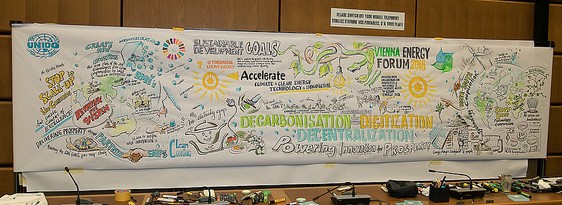
Vienna Energy Forum banner created by artists on the day © UNIDO / Flickr
Another key word that was repeatedly mentioned was finance. The question was how to raise and mobilize funds for the implementation of the required solutions and initiatives. The answer: blended funding and private funding mobilization. This means combining different funding sources, including crowd funding and citizen-social funding initiatives, and engaging the private sector by reducing the risk for investors. A wonderful example was presented by the city of Vienna, where a solar power plant was completely funded (and thus owned) by Viennese citizens through the purchase of shares.
This connects with the last message: the importance of a bottom-up approach and the critical role of those at the local level. Speakers and panelists gave several examples of successful initiatives in Mali, India, Vienna, and California. Most of the debates focused on how to search for solutions and facilitate access to funding and implementation in the Global South. However, two things became clear. Firstly, massive political and investment efforts are required in emerging countries to set up the infrastructural and social environment (including capacity building) to achieve the SDGs. Secondly, the effort and cost of dismantling a well-rooted technological and infrastructural system once put in place, such as fossil fuel-based power networks in the case of developed countries, are also huge. Hence, the importance of emerging economies going directly for sustainable solutions, which will pay off in the future in all possible aspects. HRH Princess Abze Djigma from Burkina Faso emphasized that this is already happening in Africa. Progress is being made at a critical rate, triggered by local initiatives that will displace the age of huge, donor-funded, top-down projects, to give way to bottom-up, collaborative co-funding and co-development.
Overall, if I had to pick just one message among the information overload I faced over these two days, it would be the statement by a young fellow in the audience from African Champions: “Africa is not underdeveloped, it is waiting and watching not to repeat the mistakes made by the rest of the world.” We should keep this message in mind.
Mar 15, 2018 | Poverty & Equity, Women in Science
Monika Bauer, IIASA Alumni Officer
International Women’s Day is celebrated worldwide every year on 8 March. The event aims to promote the work and rights of women. This year, IIASA celebrated International Women’s Day with a panel discussion which asked the question, “Can a women-empowered world resolve some of the global sustainability challenges?” IIASA Population Researcher Raya Muttarak, moderated the panel that included Tyseer Aboulnasr, Melody Mentz, Shonali Pachauri, and Mary Scholes.
“The IIASA Women in Science Club chose this topic because it would allow the panelists to reflect on the potential welfare benefits of a more gender-balanced world. We wanted to know if balance could benefit both women and men, and we wanted to provide a space to discuss the potential intersectionality of the challenges to female empowerment such as poverty, racism, sexism, access to education, health autonomy, and resource inequality,” said organizer Amanda Palazzo, IIASA Ecosystems Services and Management researcher.
IIASA Director General and CEO Professor Dr. Pavel Kabat opened the discussion by offering a brief history of International Women’s Day in the context of the early history of IIASA.
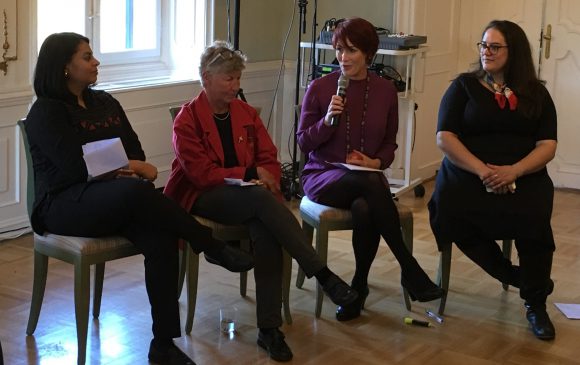
Melody Mentz gives her thoughts
Mentz, an independent higher education research and evaluation consultant based in South Africa, spoke about the implications that a gender-balanced world could hold for science and sustainability using the African agricultural system as an example. To this end, she presented a few statistics that show how the African food system intersects with the sustainable development goal of gender equality.
According to the most recent Food and Agriculture Organization of the United Nations study, women do up to 50 % of agricultural labor in Africa (this varies by country). Bearing this fact in mind, women however, own only 10 % of the land in Africa; they receive less than 10% of the investments in agriculture on the continent; and less than 5% of women have access to advisory services. In addition, they hold just 14% of management positions in the sector, and only one in four agricultural researchers on the continent is female.
“There is a huge disparity between the contributions of women, the impact of the current food system on women, and the role that the environment allows them to play,” explained Mentz.
As far as the implications of this are concerned, the first, and perhaps the most obvious, is that we need more women in science. Secondly, according to Mentz, we also need more science for women.
“At an institutional level we [should] start thinking differently about what kind of questions we answer. Those questions don’t have to be focused on women, but rather, should consider the implications for both men and women,” she said.
Thirdly, she argued for more science with women, as many research questions and research designs are not just driven by scientists, but actually originate with the people that researchers are trying to help. Finally, we also need more science about women, meaning that data and indicators of impact need to include gender, especially in the context of Africa.
IIASA Energy Researcher Pachauri reflected on the inequalities that we see in our everyday lives. Her work specializes in household energy access in the developing world. Pachauri shared an example from an organization called ENERGIA, of which she is a member of the advisory board, where women were included as microentrepreneurs in the delivery of energy in villages. The organization found that female entrepreneurs were more successful and profitable than the men, which they put down to a greater use of social networks and relationships. The example demonstrated how societies can benefit from including women in solutions for everyday problems.
Aboulnasr, a retired electrical engineering professor, focused on the importance of balance – whether it is a balance of genders, social classes, or geography. Aboulnasr eloquently suggested that rather than striving for perfect balance, one should accept a more dynamic and changing balance. She also stated that one should focus on the impact, rather than on the tools. For example, excellent science is a tool for reaching a goal that makes an impact, rather than excellence in science being the goal. Her advice to the audience was to be open to accepting failure in one’s life.
“If you don’t fail in 30% of what you attempt to do, then you have never reached your limits,” she said, and encouraged the audience to stop obsessing about the failures of the past, seek balance, and to not feel guilty.
Scholes, a professor at the University of Witwatersrand in South Africa, approached the question of the day differently. She urged the audience to look at the question from a sustainability perspective, and to ask what role gender has to play in stewardship for the planet. In addition, she asked the audience to consider whether our unstainable use of resources is because of gender inequality, or because of a more underlying misalignment of values, and what type of empowerment might be needed to achieve a more sustainable world.
“As far as we know, this is the first panel discussion hosted at IIASA which has specifically tried to examine the role of women in achieving a sustainable future. We learned that there are pockets of IIASA research already exploring this this issue and that there is room and interest to engage in this discussion in the future,” says Palazzo.
It is clear that there is no simple answer to the issues surrounding the topic of our International Women’s Day panel discussion. The event however, highlighted unique reflections and experiences from each panelist, and the IIASA Women in Science Club will continue to explore and push the discussion forward. We look forward to updating you soon.
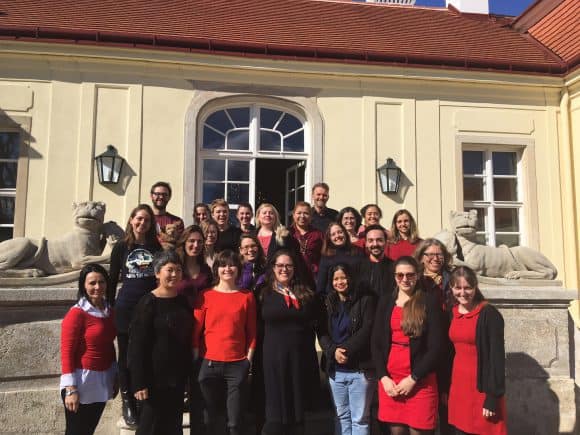
Some of of the panel discussion attendees wearing red, purple and black themed clothes for International Women’s Day












You must be logged in to post a comment.